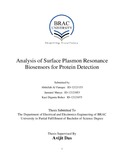Analysis of surface plasmon resonance biosensors for protein detection
Abstract
The Surface Plasmon Resonance (SPR) biosensor method has emerged as a very flexible and powerful approach for detecting a wide diversity of bio-molecular interactions. This Surface Plasmon Resonance (SPR) for boisensoring was demonstrated 40 years ago. In the present contribution, its general background is described together with the necessary developments both in instrumentation and surface chemistry, the high cost of commercial medical devices and consumable has prevented SPR from being introduced in the undergraduate laboratory. The object is to analyze surface plasmon resonance biosensor for protein detection to improve the sensitivity of medical devices and to ease disease detection. Modelling of the SPR response by using a computer program which calculates program which calculates reflection and transmission of polarized light in a satisfied structure (stack of parallel layers) sandwiched between semi-infinite substrate (prism) and ambient (sample solution) media is also used.

